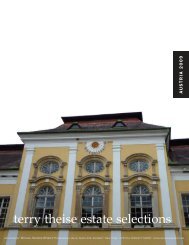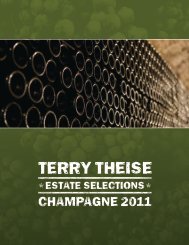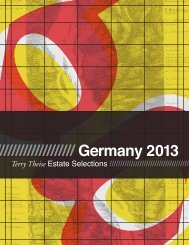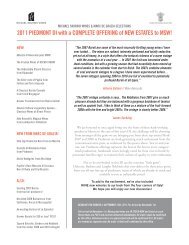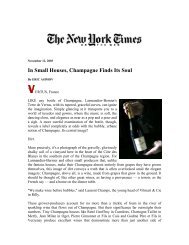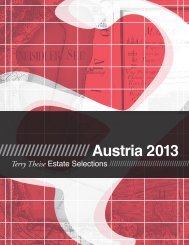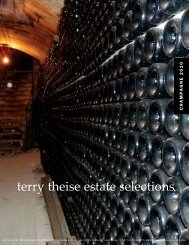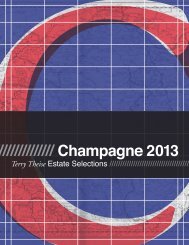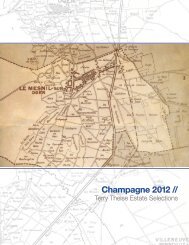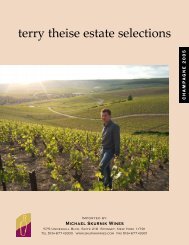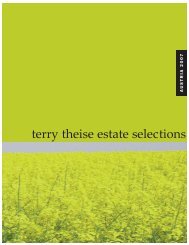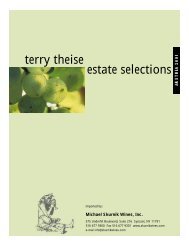German Catalog 2006 USE THIS ONE.qxp - Michael Skurnik Wines
German Catalog 2006 USE THIS ONE.qxp - Michael Skurnik Wines
German Catalog 2006 USE THIS ONE.qxp - Michael Skurnik Wines
Create successful ePaper yourself
Turn your PDF publications into a flip-book with our unique Google optimized e-Paper software.
NAHE WINES<br />
112<br />
Meddersheimer Rheingrafenberg. (It is fine with me if<br />
you want simply to call it “the Grafenberg spot”.)<br />
This is a steep southward hillside crawling off into<br />
two lateral valleys.<br />
The soil is based on<br />
sandy loam but, this<br />
being after all the<br />
Nahe, it ends up<br />
being a complicated<br />
melange of various<br />
weathered products,<br />
slate, sandstone and<br />
Rheingrafenberg Rock at Hexamer<br />
other conglomerates<br />
among them. The<br />
first time I sniffed a Hexamer from this site I was immediately<br />
delighted: a true terroir wine. In fact we took a PIC-<br />
TURE of a big ol’ rock from the Rheingrafenberg Harald<br />
keeps in his tasting room. It looks like something the Mars<br />
rover might have found. If you’re reading the on-line version<br />
of this text the color shot should be nearby.<br />
These wines have been consistently impressive for<br />
their dicht (which translates as “density”), delineation,<br />
and charm. Think about it. How many wines exhibit all<br />
three qualities? Density usually precludes charm.<br />
Delineation often presupposes a certain transparent<br />
lightness. These are rare and wonderful wines,<br />
sybarites; I’m not looking to add estates to this portfolio<br />
in my advancing decrepitude unless they offer irresistible<br />
deliciousness.<br />
Hexamer is emblematic of the best of cutting edge<br />
thinking among quality-minded vintners. He’s a vineyardist<br />
first, only thereafter a cellarmaster. “I can only<br />
attempt to optimize in the cellar what I pull from the vineyard;<br />
the quality of the grapes is decisive.” He often harvests<br />
riper grapes from another site (Marbach) but the<br />
wines of Rheingrafenberg are “more filigree and better-<br />
hexamer at a glance:<br />
en wines of terroir.<br />
structured.” He handles as little as possible. Doesn’t<br />
deacidify, doesn’t use dosage. The grapes are picked exclusively<br />
by hand and fermented very cold (below 12 degrees<br />
celsius) with cooling when necessary (“but we often pick<br />
so late we bring naturally cold fruit — below 10 degrees<br />
— back to the winery.”) Yields are controlled by pruning<br />
(“We often end up with only six to eight bunches per<br />
vine”). Most of the wines are whole-cluster pressed; “The<br />
most filigree wines come from this method.” 95% of all<br />
Rieslings are made in stainless steel, and only racked three<br />
to six weeks after fermentation is complete. The wines are<br />
bottled early to preserve their vigor.<br />
All quite modern, yet Hexamer’s not what I’d call a<br />
modernist. Rather, he seeks the most neutral cellar-environment<br />
so as to preserve the complexities he pulls in<br />
from the mountain. He’s also a fun guy to drink wine<br />
with, and shows ceaseless curiosity and omnivorous glee<br />
in all the world’s wines.<br />
Acidity has been a theme here the past three vintages,<br />
less for its actual extent and more for the way it<br />
behaves; Hexamer’s wines are (if you like them) “brilliant”<br />
and (if you don’t like them) “tart”. This was also<br />
the case in the generally low-acid 2005s. Mind you, I<br />
don’t actually know if the wines are high in acidity; they<br />
just taste that way. In fact I only ever ask to see analyses<br />
to confirm an impression or to have a starting point for<br />
dosage blends. My favorite growers hardly look at all.<br />
Dönnhoff told me last summer he never looks at analyses<br />
once the grapes are in the press. “I’ll check during harvest<br />
for Oechsle and acidity, but once the press is running<br />
how can it possibly help me to know the figures? I can’t<br />
do anything about them; all they do is cause me to worry<br />
needlessly.” For better or worse — in his case, better —<br />
he trusts his palate. And he’s influencing a young generation<br />
who are blessed with his encouragement to trust<br />
their wits and senses.<br />
Sensational new discovery on the upper Nahe, a young<br />
vintner doing everything right; handcrafted fruit-driv-<br />
Anti-varietal in the best sense, the same way that<br />
how the wines taste:<br />
Condrieu isn’t merely viognier; the best from the<br />
Rheingrafenberg are wines of deep site-character as rendered by riesling. Splendidly mineral<br />
wines into which fruit of great charm is interwoven. Fresh, with exceptional purity.<br />
GHX-023 2004 Meddersheimer Rheingrafenberg Riesling Kabinett<br />
A delicate, intricately articulate Riesling with a keen curranty length; though it enters<br />
with an almost soy-shiitae low note, it quickly shows a quince-rosewater high note; it<br />
is a perfection of perhaps the most unique and precious facet of <strong>German</strong> Riesling; this<br />
gossamer lightness and laser-etching of flavor, but with endless length.<br />
SOS: 2 (between six and seventeen years)<br />
GHX-029 2005 Meddersheimer Rheingrafenberg Riesling Kabinett<br />
There’s very little of this, and we won’t begin selling it until the `04 is gone — probably<br />
late Winter. It’s a no-quarter-given Riesling with a piercing flower and mineral fragrance;<br />
one of his first-picked, with 93º, from the Eisendell parcel, which is “not one of<br />
the best, but look at the ripeness!” It shows really zippy acids and a minty finish, like a<br />
verbena infusion poured over smashed rocks. You know you want it!<br />
SOS: 1 (6-23 years)



